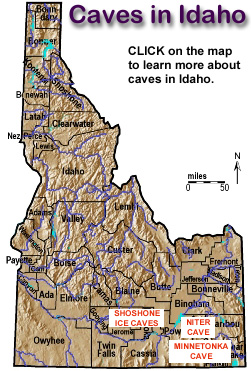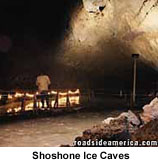
|
 |
Caves in Idaho generally fall into one of three types: corrosion caves, solution caves and lava caves.
Click here to look at the inside of a limestone solution cave.
Corrosion Caves
Corrosion caves are formed by erosive action of water, waves or currents on a relatively soft rock. These caves generally occur at the edge of a river or lake.
Corrosion caves are generally shallow and not as impressive as lava caves or solution caves. Archeologists, however, have found that early man commonly camped in small corrosion caves while hunting or fishing in the vicinity of water bodies.
Rock shelters are also formed by erosion recessing the lower rocks in a cliff and leaving an overhanging rock shelter. Many of these rock shelters have yielded valuable information on the culture and migration patterns of early man in Idaho.
Solution Caves
Solution caves are formed by slightly acidic ground water circulating through fractures in limestone. This water is capable of dissolving great quantities of solid rock. As time passes, the openings become larger and larger until they may be large enough for a man to pass through.
Cone-shaped forms called stalactites are deposited by underground water. Stalactites are composed of calcium carbonate and look like icicles hanging from cave roofs. Stalagmites are similar in composition and origin to stalactites but are formed from ground water dripping on the cave floor. The best examples of solution caves are found in the Paleozoic carbonate rocks in eastern Idaho.
Lava Caves
Lava caves, also known as lava tubes, form in the central portion of a lava flow. Immediately after the flow is extruded, the outer margins of the flow cool and freeze in place, including the bottom, sides and top. Although the outer margin of the flow has solidified into basaltic rock, the central core is still molten and continues to flow towards the flow front. When the source of lava is cut off, the lava flows out the end of the tube and leaves a cave. These caves are typically 10 to 20 feet in diameter. They are characterized by both stalactites and stalagmites formed by lava dripping off the roof of the tube. Basalt flows on the Snake River Plain have many excellent examples of these caves. Many such caves are found where a thin portion of the roof collapses and leaves a precarious entrance to the cave.